Leadership & Management: Impact of Internal Environment on Ngai Tahu
VerifiedAdded on 2023/04/24
|13
|1995
|350
Report
AI Summary
This report examines the impact of the internal environment on Ngai Tahu Holdings, a New Zealand-based private holding corporation. It analyzes factors such as the business system, business structure, business resources, and organizational structure, highlighting the company's personnel-driven values and tribal engagement. The report also employs quantitative and qualitative analytical tools to measure internal growth, specifically focusing on Ngai Tahu Tourism. Quantitative analysis uses correlation techniques on the last 5 years data to correlate the year and net operating surplus of the company, while qualitative analysis utilizes content analysis of company reports and key personnel opinions. The analysis indicates a positive growth trend, supported by strategic investments and internal development opportunities, with teamwork and diversification playing key roles in mitigating risks. Desklib provides similar solved assignments and resources for students.
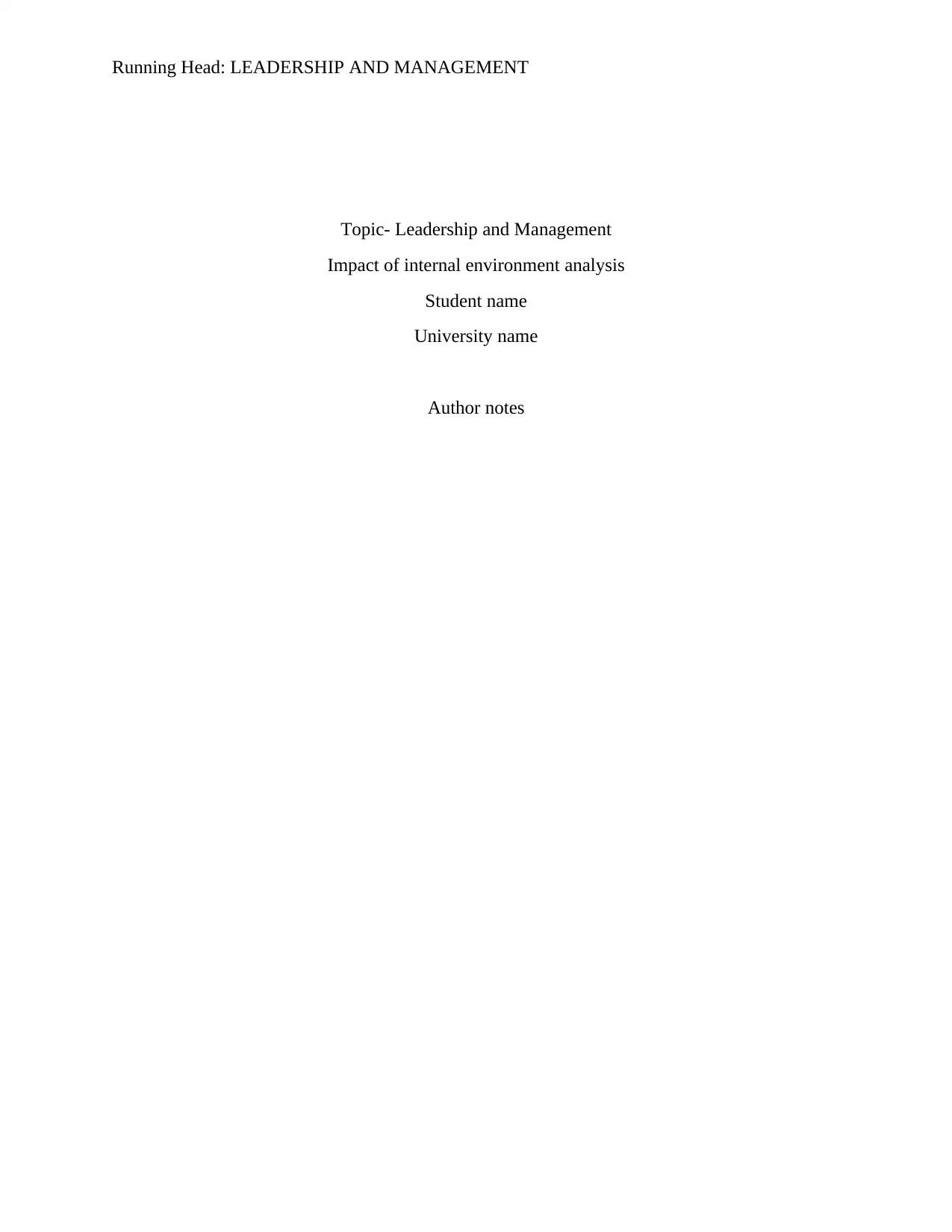
Running Head: LEADERSHIP AND MANAGEMENT
Topic- Leadership and Management
Impact of internal environment analysis
Student name
University name
Author notes
Topic- Leadership and Management
Impact of internal environment analysis
Student name
University name
Author notes
Secure Best Marks with AI Grader
Need help grading? Try our AI Grader for instant feedback on your assignments.
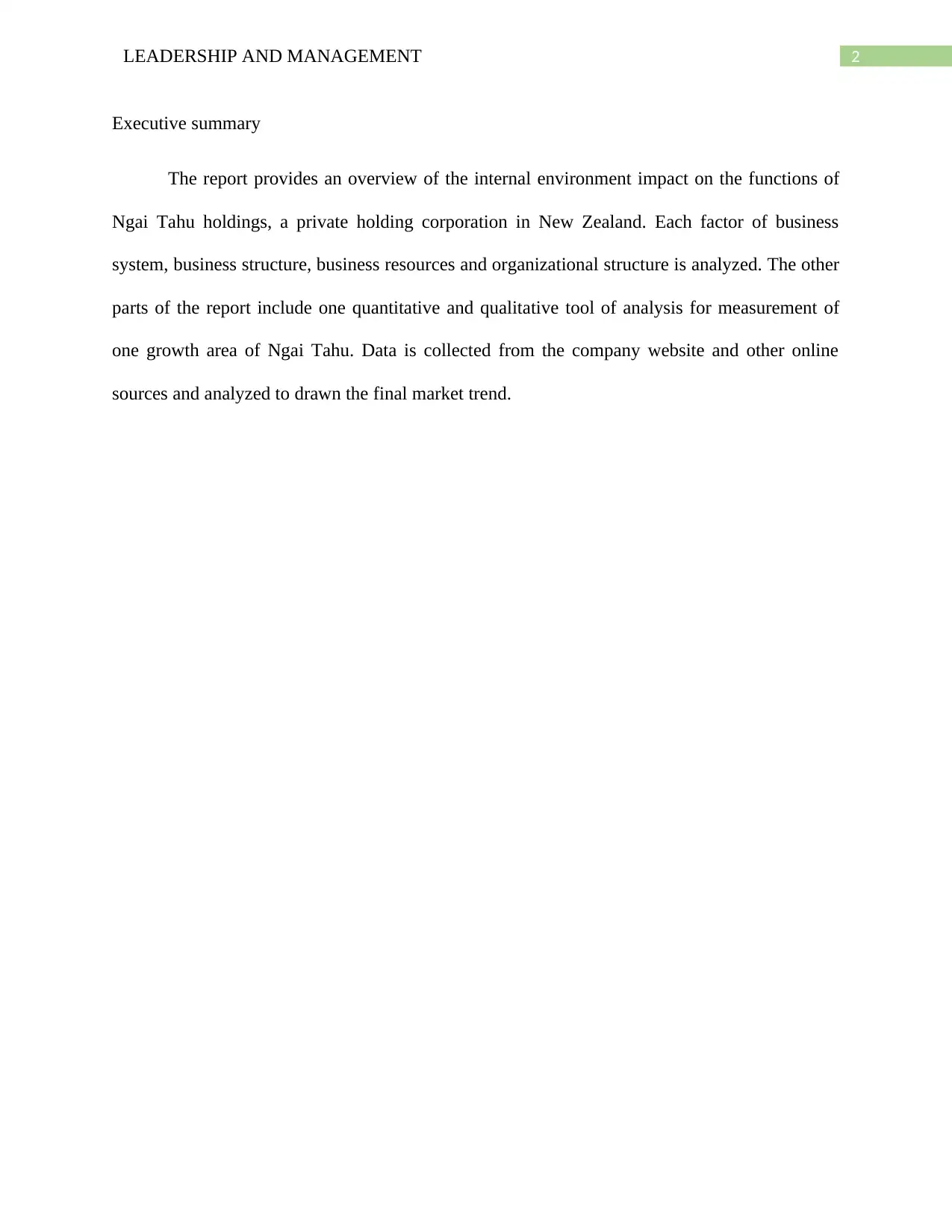
2LEADERSHIP AND MANAGEMENT
Executive summary
The report provides an overview of the internal environment impact on the functions of
Ngai Tahu holdings, a private holding corporation in New Zealand. Each factor of business
system, business structure, business resources and organizational structure is analyzed. The other
parts of the report include one quantitative and qualitative tool of analysis for measurement of
one growth area of Ngai Tahu. Data is collected from the company website and other online
sources and analyzed to drawn the final market trend.
Executive summary
The report provides an overview of the internal environment impact on the functions of
Ngai Tahu holdings, a private holding corporation in New Zealand. Each factor of business
system, business structure, business resources and organizational structure is analyzed. The other
parts of the report include one quantitative and qualitative tool of analysis for measurement of
one growth area of Ngai Tahu. Data is collected from the company website and other online
sources and analyzed to drawn the final market trend.
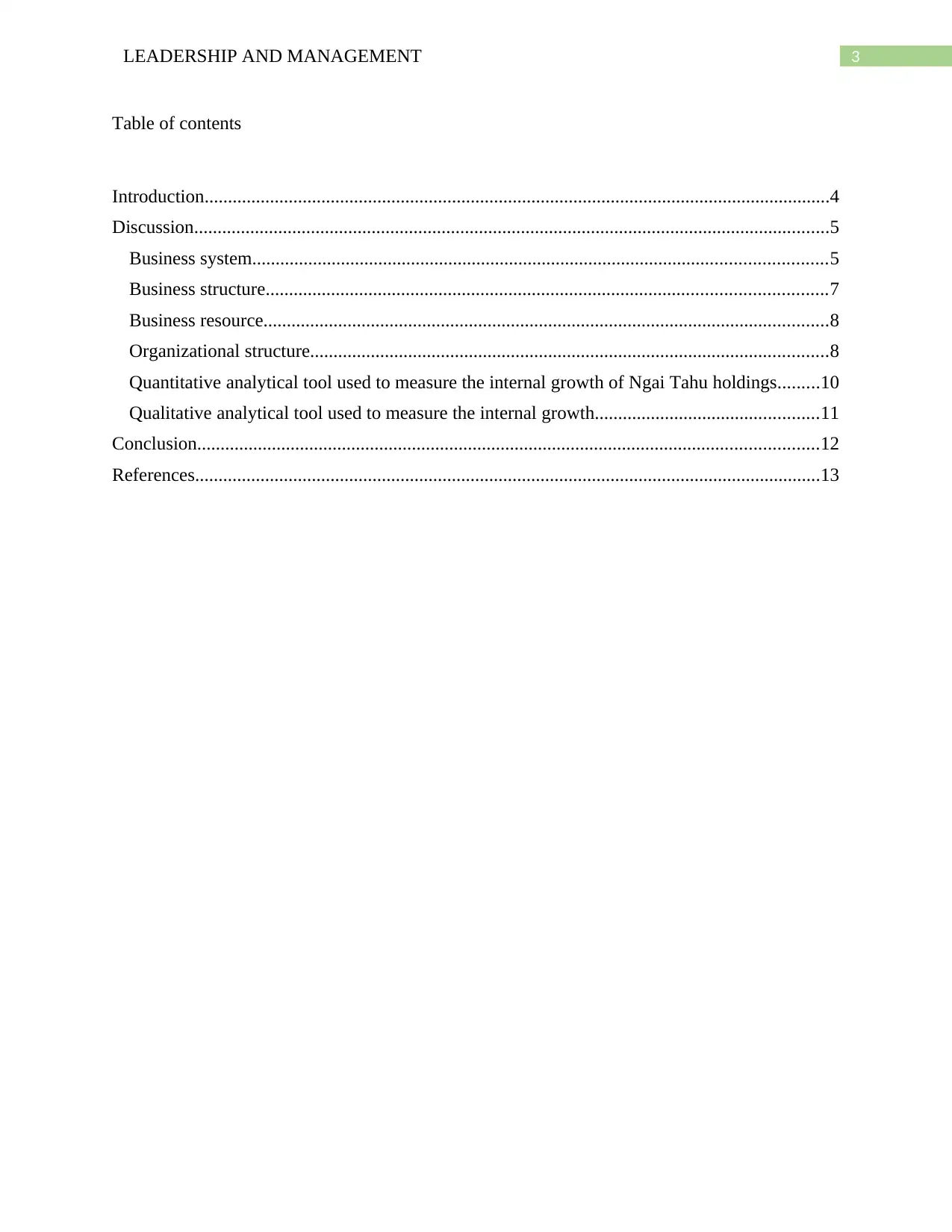
3LEADERSHIP AND MANAGEMENT
Table of contents
Introduction......................................................................................................................................4
Discussion........................................................................................................................................5
Business system...........................................................................................................................5
Business structure........................................................................................................................7
Business resource.........................................................................................................................8
Organizational structure...............................................................................................................8
Quantitative analytical tool used to measure the internal growth of Ngai Tahu holdings.........10
Qualitative analytical tool used to measure the internal growth................................................11
Conclusion.....................................................................................................................................12
References......................................................................................................................................13
Table of contents
Introduction......................................................................................................................................4
Discussion........................................................................................................................................5
Business system...........................................................................................................................5
Business structure........................................................................................................................7
Business resource.........................................................................................................................8
Organizational structure...............................................................................................................8
Quantitative analytical tool used to measure the internal growth of Ngai Tahu holdings.........10
Qualitative analytical tool used to measure the internal growth................................................11
Conclusion.....................................................................................................................................12
References......................................................................................................................................13
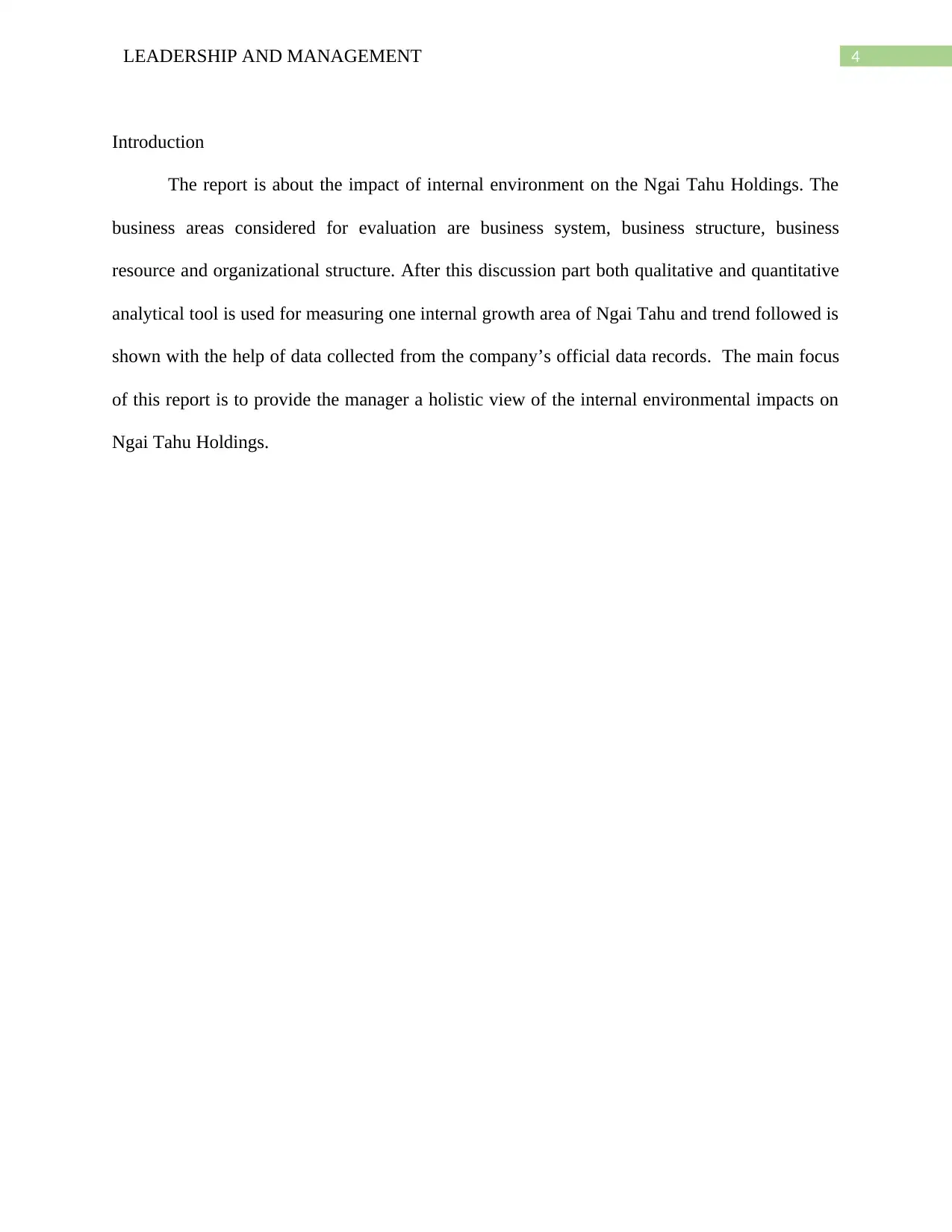
4LEADERSHIP AND MANAGEMENT
Introduction
The report is about the impact of internal environment on the Ngai Tahu Holdings. The
business areas considered for evaluation are business system, business structure, business
resource and organizational structure. After this discussion part both qualitative and quantitative
analytical tool is used for measuring one internal growth area of Ngai Tahu and trend followed is
shown with the help of data collected from the company’s official data records. The main focus
of this report is to provide the manager a holistic view of the internal environmental impacts on
Ngai Tahu Holdings.
Introduction
The report is about the impact of internal environment on the Ngai Tahu Holdings. The
business areas considered for evaluation are business system, business structure, business
resource and organizational structure. After this discussion part both qualitative and quantitative
analytical tool is used for measuring one internal growth area of Ngai Tahu and trend followed is
shown with the help of data collected from the company’s official data records. The main focus
of this report is to provide the manager a holistic view of the internal environmental impacts on
Ngai Tahu Holdings.
Secure Best Marks with AI Grader
Need help grading? Try our AI Grader for instant feedback on your assignments.
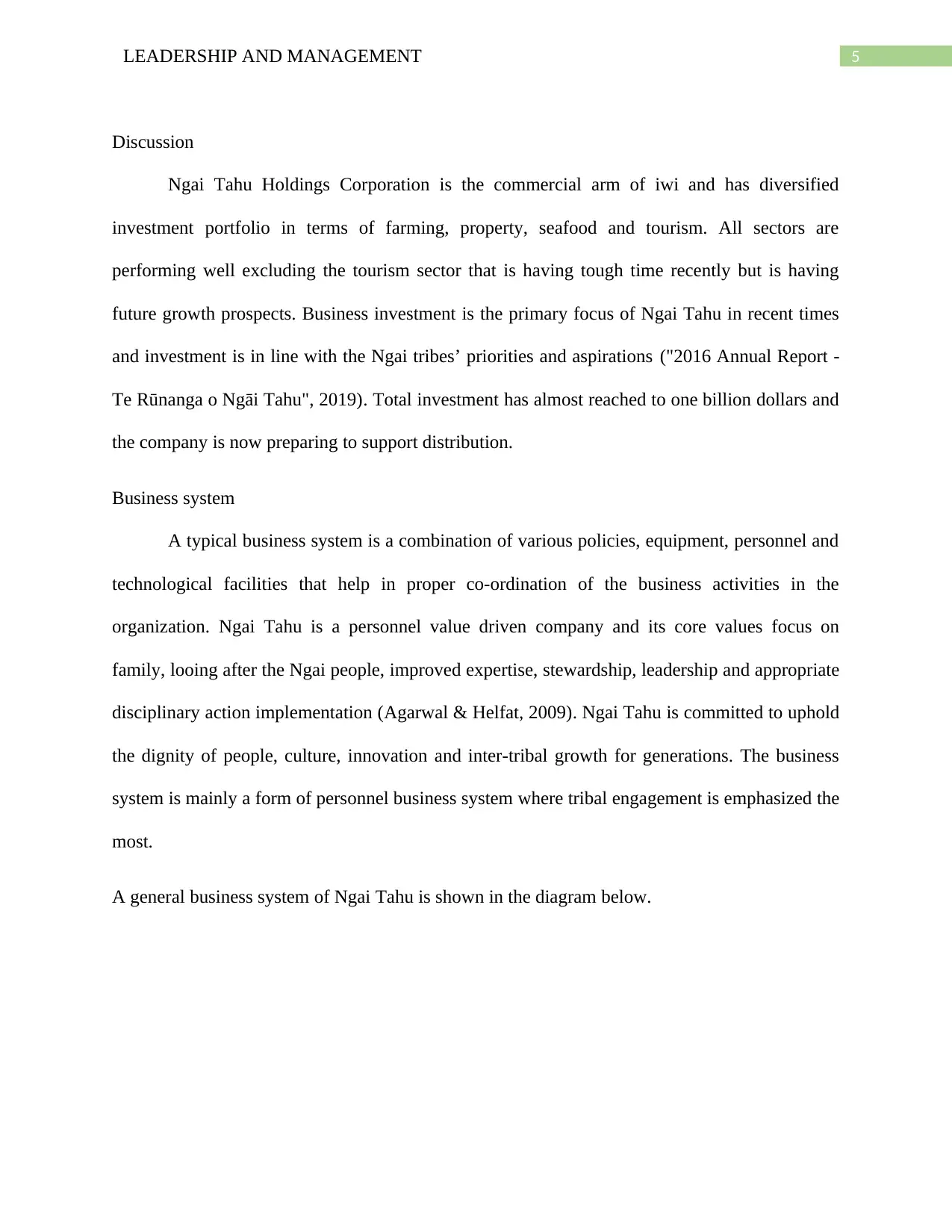
5LEADERSHIP AND MANAGEMENT
Discussion
Ngai Tahu Holdings Corporation is the commercial arm of iwi and has diversified
investment portfolio in terms of farming, property, seafood and tourism. All sectors are
performing well excluding the tourism sector that is having tough time recently but is having
future growth prospects. Business investment is the primary focus of Ngai Tahu in recent times
and investment is in line with the Ngai tribes’ priorities and aspirations ("2016 Annual Report -
Te Rūnanga o Ngāi Tahu", 2019). Total investment has almost reached to one billion dollars and
the company is now preparing to support distribution.
Business system
A typical business system is a combination of various policies, equipment, personnel and
technological facilities that help in proper co-ordination of the business activities in the
organization. Ngai Tahu is a personnel value driven company and its core values focus on
family, looing after the Ngai people, improved expertise, stewardship, leadership and appropriate
disciplinary action implementation (Agarwal & Helfat, 2009). Ngai Tahu is committed to uphold
the dignity of people, culture, innovation and inter-tribal growth for generations. The business
system is mainly a form of personnel business system where tribal engagement is emphasized the
most.
A general business system of Ngai Tahu is shown in the diagram below.
Discussion
Ngai Tahu Holdings Corporation is the commercial arm of iwi and has diversified
investment portfolio in terms of farming, property, seafood and tourism. All sectors are
performing well excluding the tourism sector that is having tough time recently but is having
future growth prospects. Business investment is the primary focus of Ngai Tahu in recent times
and investment is in line with the Ngai tribes’ priorities and aspirations ("2016 Annual Report -
Te Rūnanga o Ngāi Tahu", 2019). Total investment has almost reached to one billion dollars and
the company is now preparing to support distribution.
Business system
A typical business system is a combination of various policies, equipment, personnel and
technological facilities that help in proper co-ordination of the business activities in the
organization. Ngai Tahu is a personnel value driven company and its core values focus on
family, looing after the Ngai people, improved expertise, stewardship, leadership and appropriate
disciplinary action implementation (Agarwal & Helfat, 2009). Ngai Tahu is committed to uphold
the dignity of people, culture, innovation and inter-tribal growth for generations. The business
system is mainly a form of personnel business system where tribal engagement is emphasized the
most.
A general business system of Ngai Tahu is shown in the diagram below.
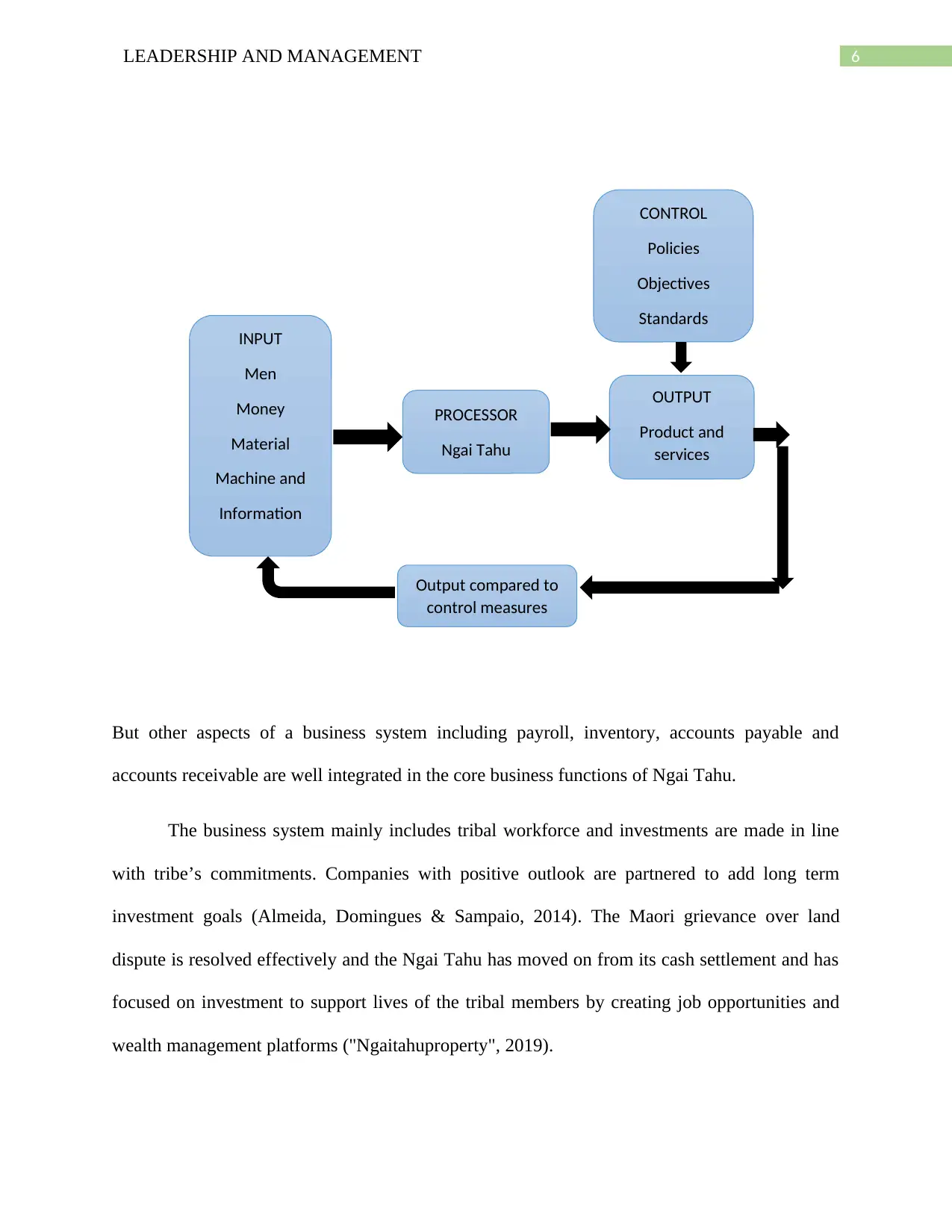
6LEADERSHIP AND MANAGEMENT
But other aspects of a business system including payroll, inventory, accounts payable and
accounts receivable are well integrated in the core business functions of Ngai Tahu.
The business system mainly includes tribal workforce and investments are made in line
with tribe’s commitments. Companies with positive outlook are partnered to add long term
investment goals (Almeida, Domingues & Sampaio, 2014). The Maori grievance over land
dispute is resolved effectively and the Ngai Tahu has moved on from its cash settlement and has
focused on investment to support lives of the tribal members by creating job opportunities and
wealth management platforms ("Ngaitahuproperty", 2019).
INPUT
Men
Money
Material
Machine and
Information
OUTPUT
Product and
services
CONTROL
Policies
Objectives
Standards
PROCESSOR
Ngai Tahu
Output compared to
control measures
But other aspects of a business system including payroll, inventory, accounts payable and
accounts receivable are well integrated in the core business functions of Ngai Tahu.
The business system mainly includes tribal workforce and investments are made in line
with tribe’s commitments. Companies with positive outlook are partnered to add long term
investment goals (Almeida, Domingues & Sampaio, 2014). The Maori grievance over land
dispute is resolved effectively and the Ngai Tahu has moved on from its cash settlement and has
focused on investment to support lives of the tribal members by creating job opportunities and
wealth management platforms ("Ngaitahuproperty", 2019).
INPUT
Men
Money
Material
Machine and
Information
OUTPUT
Product and
services
CONTROL
Policies
Objectives
Standards
PROCESSOR
Ngai Tahu
Output compared to
control measures
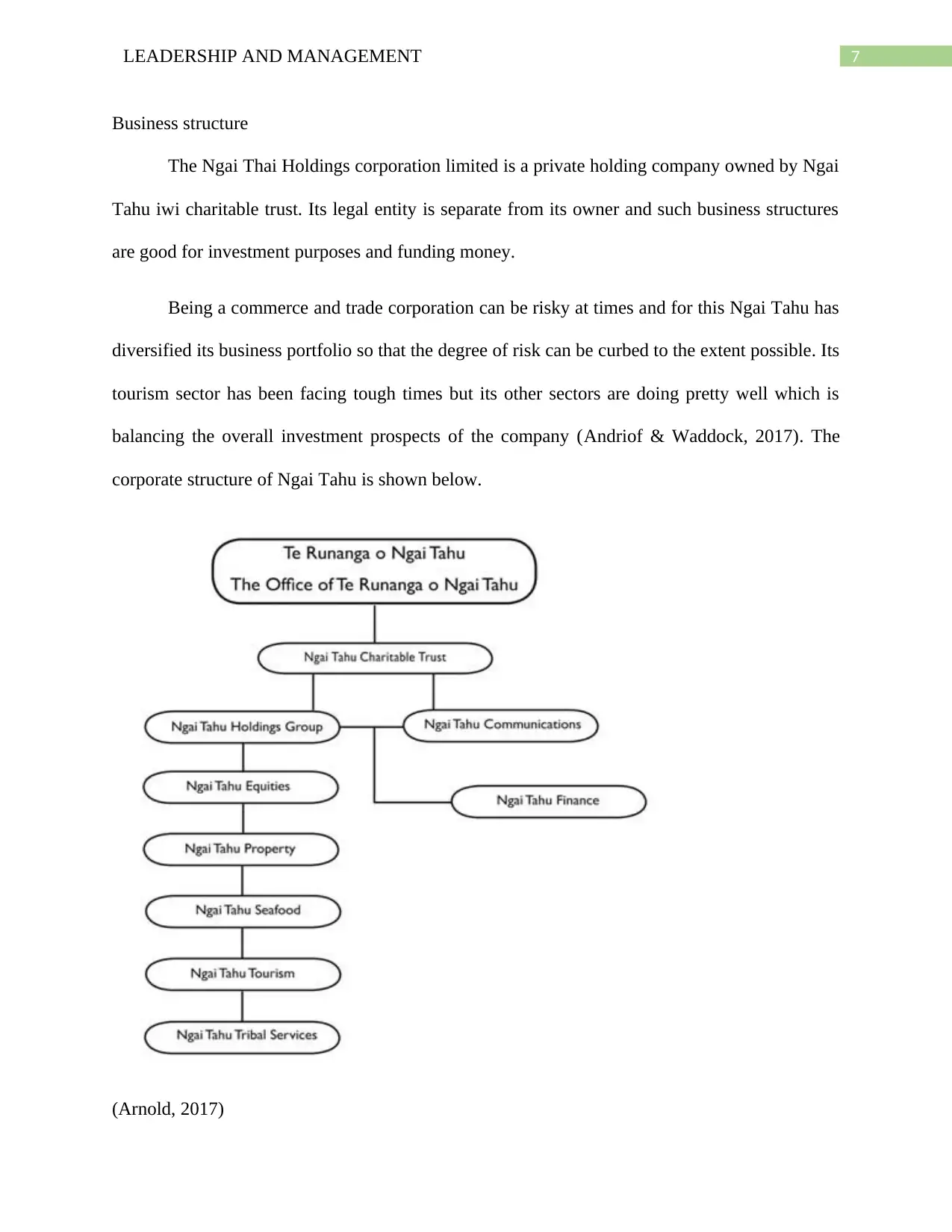
7LEADERSHIP AND MANAGEMENT
Business structure
The Ngai Thai Holdings corporation limited is a private holding company owned by Ngai
Tahu iwi charitable trust. Its legal entity is separate from its owner and such business structures
are good for investment purposes and funding money.
Being a commerce and trade corporation can be risky at times and for this Ngai Tahu has
diversified its business portfolio so that the degree of risk can be curbed to the extent possible. Its
tourism sector has been facing tough times but its other sectors are doing pretty well which is
balancing the overall investment prospects of the company (Andriof & Waddock, 2017). The
corporate structure of Ngai Tahu is shown below.
(Arnold, 2017)
Business structure
The Ngai Thai Holdings corporation limited is a private holding company owned by Ngai
Tahu iwi charitable trust. Its legal entity is separate from its owner and such business structures
are good for investment purposes and funding money.
Being a commerce and trade corporation can be risky at times and for this Ngai Tahu has
diversified its business portfolio so that the degree of risk can be curbed to the extent possible. Its
tourism sector has been facing tough times but its other sectors are doing pretty well which is
balancing the overall investment prospects of the company (Andriof & Waddock, 2017). The
corporate structure of Ngai Tahu is shown below.
(Arnold, 2017)
Paraphrase This Document
Need a fresh take? Get an instant paraphrase of this document with our AI Paraphraser
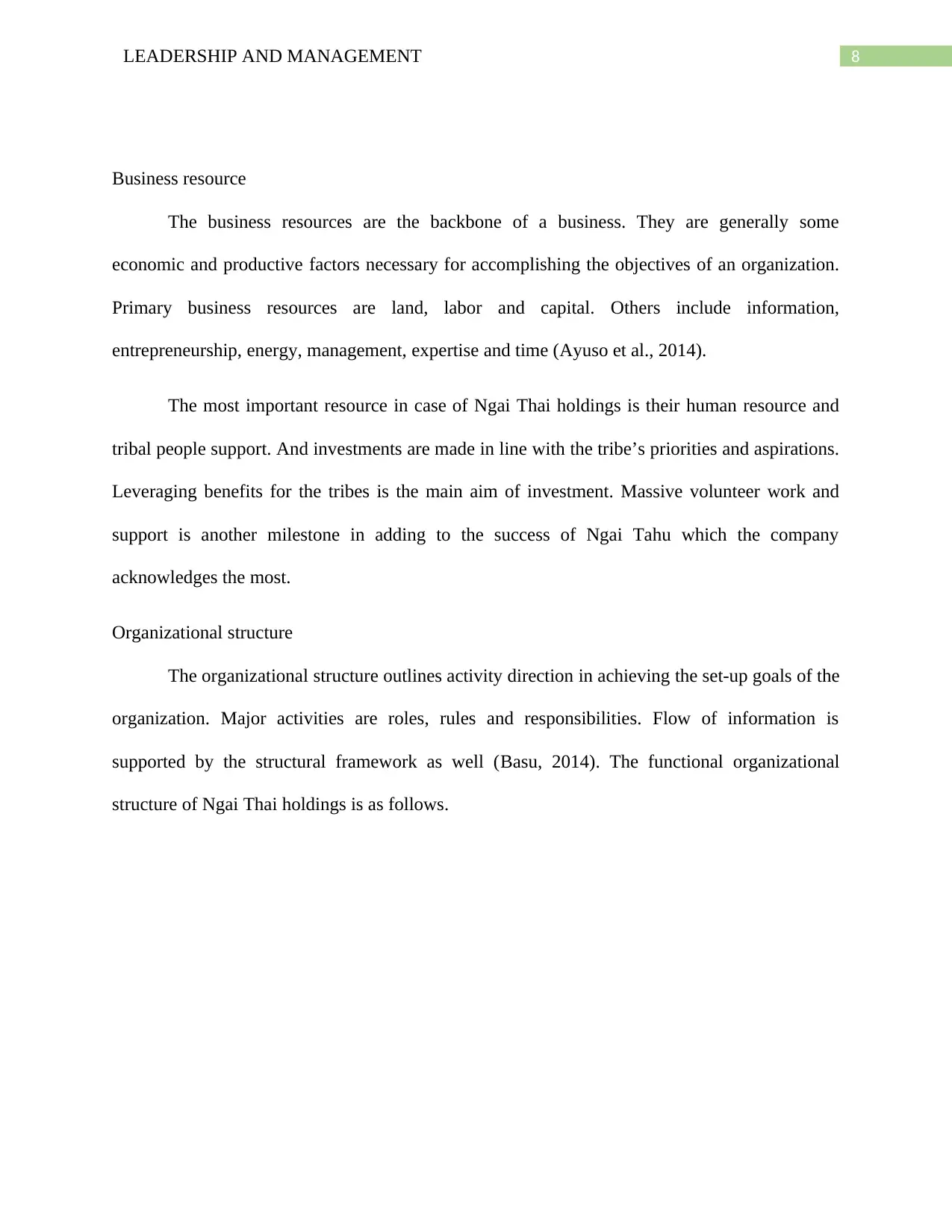
8LEADERSHIP AND MANAGEMENT
Business resource
The business resources are the backbone of a business. They are generally some
economic and productive factors necessary for accomplishing the objectives of an organization.
Primary business resources are land, labor and capital. Others include information,
entrepreneurship, energy, management, expertise and time (Ayuso et al., 2014).
The most important resource in case of Ngai Thai holdings is their human resource and
tribal people support. And investments are made in line with the tribe’s priorities and aspirations.
Leveraging benefits for the tribes is the main aim of investment. Massive volunteer work and
support is another milestone in adding to the success of Ngai Tahu which the company
acknowledges the most.
Organizational structure
The organizational structure outlines activity direction in achieving the set-up goals of the
organization. Major activities are roles, rules and responsibilities. Flow of information is
supported by the structural framework as well (Basu, 2014). The functional organizational
structure of Ngai Thai holdings is as follows.
Business resource
The business resources are the backbone of a business. They are generally some
economic and productive factors necessary for accomplishing the objectives of an organization.
Primary business resources are land, labor and capital. Others include information,
entrepreneurship, energy, management, expertise and time (Ayuso et al., 2014).
The most important resource in case of Ngai Thai holdings is their human resource and
tribal people support. And investments are made in line with the tribe’s priorities and aspirations.
Leveraging benefits for the tribes is the main aim of investment. Massive volunteer work and
support is another milestone in adding to the success of Ngai Tahu which the company
acknowledges the most.
Organizational structure
The organizational structure outlines activity direction in achieving the set-up goals of the
organization. Major activities are roles, rules and responsibilities. Flow of information is
supported by the structural framework as well (Basu, 2014). The functional organizational
structure of Ngai Thai holdings is as follows.
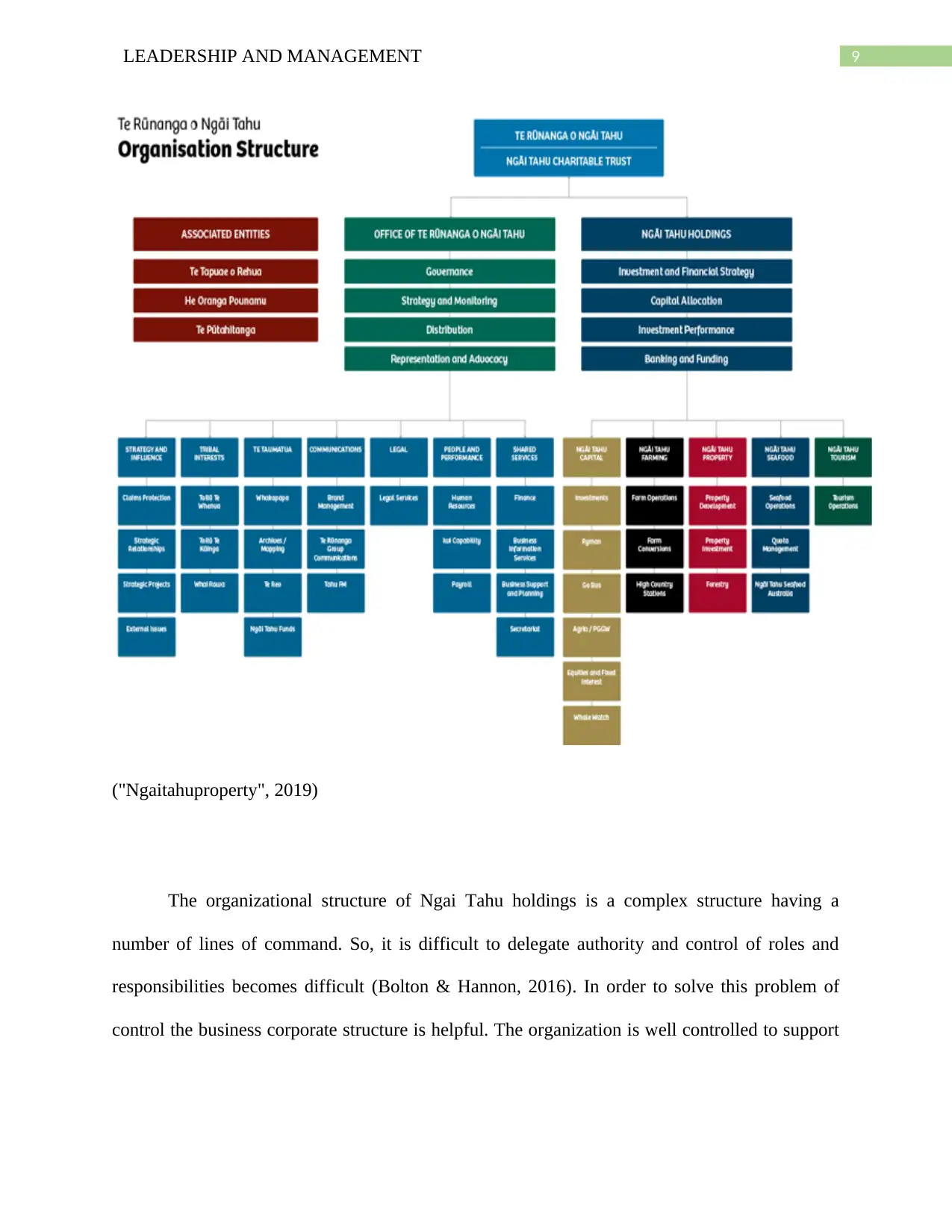
9LEADERSHIP AND MANAGEMENT
("Ngaitahuproperty", 2019)
The organizational structure of Ngai Tahu holdings is a complex structure having a
number of lines of command. So, it is difficult to delegate authority and control of roles and
responsibilities becomes difficult (Bolton & Hannon, 2016). In order to solve this problem of
control the business corporate structure is helpful. The organization is well controlled to support
("Ngaitahuproperty", 2019)
The organizational structure of Ngai Tahu holdings is a complex structure having a
number of lines of command. So, it is difficult to delegate authority and control of roles and
responsibilities becomes difficult (Bolton & Hannon, 2016). In order to solve this problem of
control the business corporate structure is helpful. The organization is well controlled to support
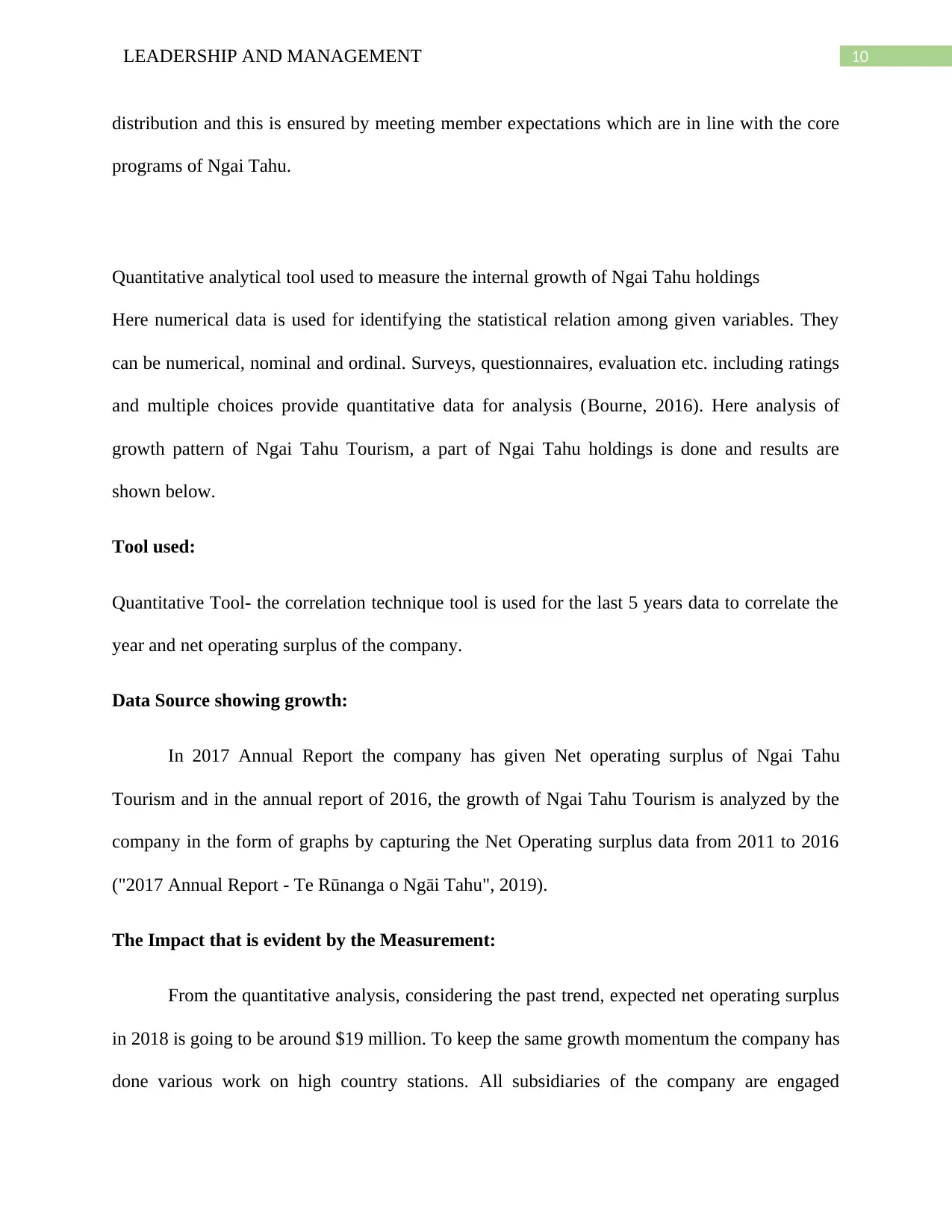
10LEADERSHIP AND MANAGEMENT
distribution and this is ensured by meeting member expectations which are in line with the core
programs of Ngai Tahu.
Quantitative analytical tool used to measure the internal growth of Ngai Tahu holdings
Here numerical data is used for identifying the statistical relation among given variables. They
can be numerical, nominal and ordinal. Surveys, questionnaires, evaluation etc. including ratings
and multiple choices provide quantitative data for analysis (Bourne, 2016). Here analysis of
growth pattern of Ngai Tahu Tourism, a part of Ngai Tahu holdings is done and results are
shown below.
Tool used:
Quantitative Tool- the correlation technique tool is used for the last 5 years data to correlate the
year and net operating surplus of the company.
Data Source showing growth:
In 2017 Annual Report the company has given Net operating surplus of Ngai Tahu
Tourism and in the annual report of 2016, the growth of Ngai Tahu Tourism is analyzed by the
company in the form of graphs by capturing the Net Operating surplus data from 2011 to 2016
("2017 Annual Report - Te Rūnanga o Ngāi Tahu", 2019).
The Impact that is evident by the Measurement:
From the quantitative analysis, considering the past trend, expected net operating surplus
in 2018 is going to be around $19 million. To keep the same growth momentum the company has
done various work on high country stations. All subsidiaries of the company are engaged
distribution and this is ensured by meeting member expectations which are in line with the core
programs of Ngai Tahu.
Quantitative analytical tool used to measure the internal growth of Ngai Tahu holdings
Here numerical data is used for identifying the statistical relation among given variables. They
can be numerical, nominal and ordinal. Surveys, questionnaires, evaluation etc. including ratings
and multiple choices provide quantitative data for analysis (Bourne, 2016). Here analysis of
growth pattern of Ngai Tahu Tourism, a part of Ngai Tahu holdings is done and results are
shown below.
Tool used:
Quantitative Tool- the correlation technique tool is used for the last 5 years data to correlate the
year and net operating surplus of the company.
Data Source showing growth:
In 2017 Annual Report the company has given Net operating surplus of Ngai Tahu
Tourism and in the annual report of 2016, the growth of Ngai Tahu Tourism is analyzed by the
company in the form of graphs by capturing the Net Operating surplus data from 2011 to 2016
("2017 Annual Report - Te Rūnanga o Ngāi Tahu", 2019).
The Impact that is evident by the Measurement:
From the quantitative analysis, considering the past trend, expected net operating surplus
in 2018 is going to be around $19 million. To keep the same growth momentum the company has
done various work on high country stations. All subsidiaries of the company are engaged
Secure Best Marks with AI Grader
Need help grading? Try our AI Grader for instant feedback on your assignments.
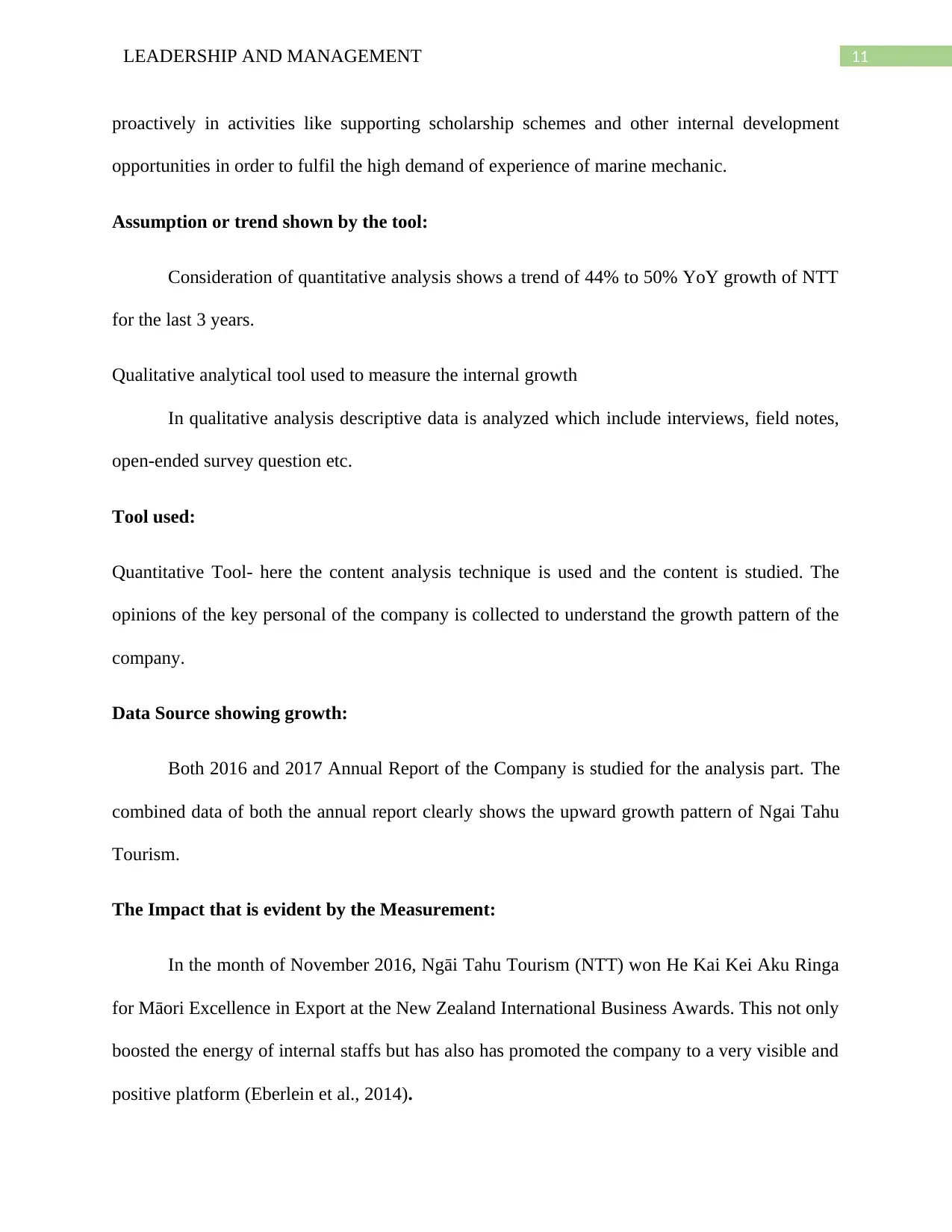
11LEADERSHIP AND MANAGEMENT
proactively in activities like supporting scholarship schemes and other internal development
opportunities in order to fulfil the high demand of experience of marine mechanic.
Assumption or trend shown by the tool:
Consideration of quantitative analysis shows a trend of 44% to 50% YoY growth of NTT
for the last 3 years.
Qualitative analytical tool used to measure the internal growth
In qualitative analysis descriptive data is analyzed which include interviews, field notes,
open-ended survey question etc.
Tool used:
Quantitative Tool- here the content analysis technique is used and the content is studied. The
opinions of the key personal of the company is collected to understand the growth pattern of the
company.
Data Source showing growth:
Both 2016 and 2017 Annual Report of the Company is studied for the analysis part. The
combined data of both the annual report clearly shows the upward growth pattern of Ngai Tahu
Tourism.
The Impact that is evident by the Measurement:
In the month of November 2016, Ngāi Tahu Tourism (NTT) won He Kai Kei Aku Ringa
for Māori Excellence in Export at the New Zealand International Business Awards. This not only
boosted the energy of internal staffs but has also has promoted the company to a very visible and
positive platform (Eberlein et al., 2014).
proactively in activities like supporting scholarship schemes and other internal development
opportunities in order to fulfil the high demand of experience of marine mechanic.
Assumption or trend shown by the tool:
Consideration of quantitative analysis shows a trend of 44% to 50% YoY growth of NTT
for the last 3 years.
Qualitative analytical tool used to measure the internal growth
In qualitative analysis descriptive data is analyzed which include interviews, field notes,
open-ended survey question etc.
Tool used:
Quantitative Tool- here the content analysis technique is used and the content is studied. The
opinions of the key personal of the company is collected to understand the growth pattern of the
company.
Data Source showing growth:
Both 2016 and 2017 Annual Report of the Company is studied for the analysis part. The
combined data of both the annual report clearly shows the upward growth pattern of Ngai Tahu
Tourism.
The Impact that is evident by the Measurement:
In the month of November 2016, Ngāi Tahu Tourism (NTT) won He Kai Kei Aku Ringa
for Māori Excellence in Export at the New Zealand International Business Awards. This not only
boosted the energy of internal staffs but has also has promoted the company to a very visible and
positive platform (Eberlein et al., 2014).
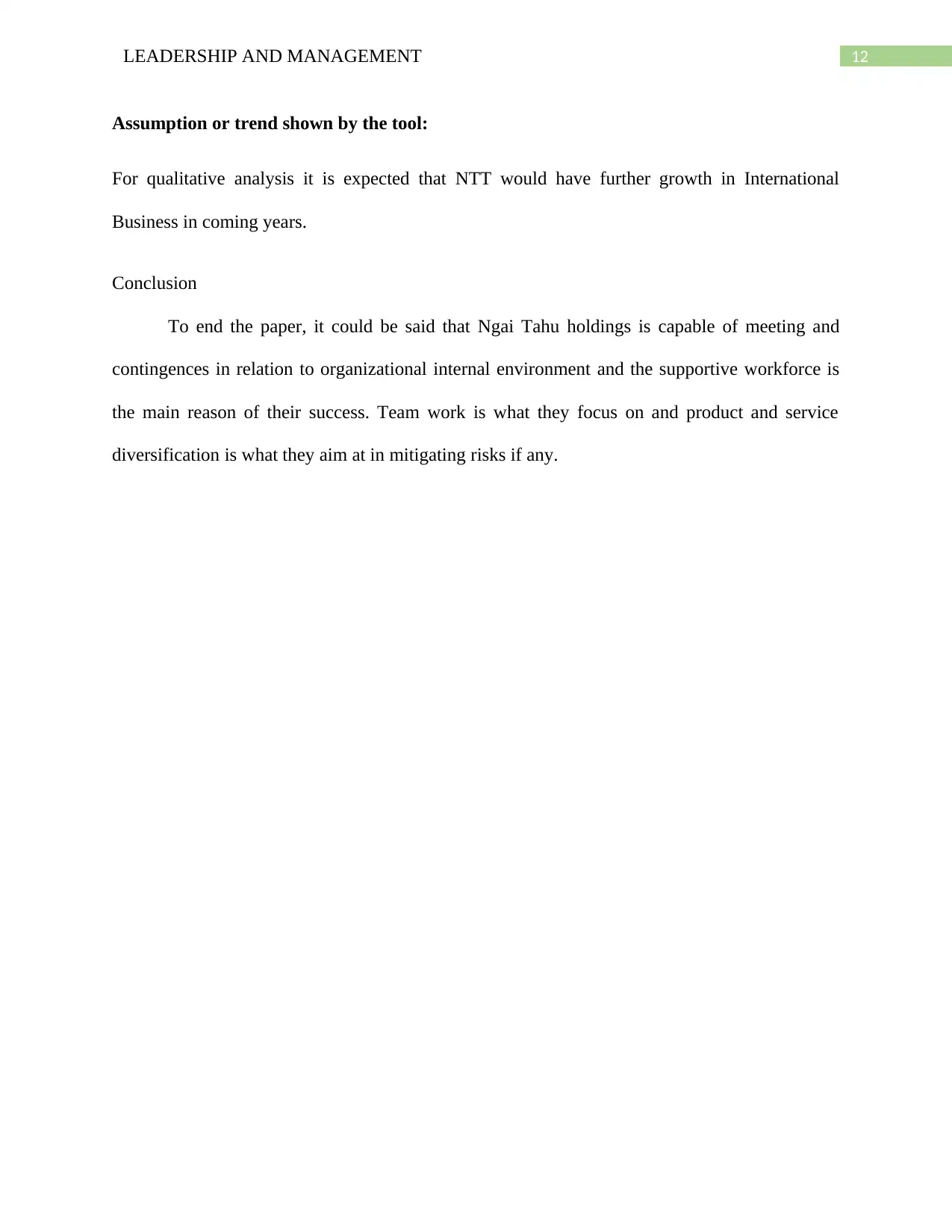
12LEADERSHIP AND MANAGEMENT
Assumption or trend shown by the tool:
For qualitative analysis it is expected that NTT would have further growth in International
Business in coming years.
Conclusion
To end the paper, it could be said that Ngai Tahu holdings is capable of meeting and
contingences in relation to organizational internal environment and the supportive workforce is
the main reason of their success. Team work is what they focus on and product and service
diversification is what they aim at in mitigating risks if any.
Assumption or trend shown by the tool:
For qualitative analysis it is expected that NTT would have further growth in International
Business in coming years.
Conclusion
To end the paper, it could be said that Ngai Tahu holdings is capable of meeting and
contingences in relation to organizational internal environment and the supportive workforce is
the main reason of their success. Team work is what they focus on and product and service
diversification is what they aim at in mitigating risks if any.
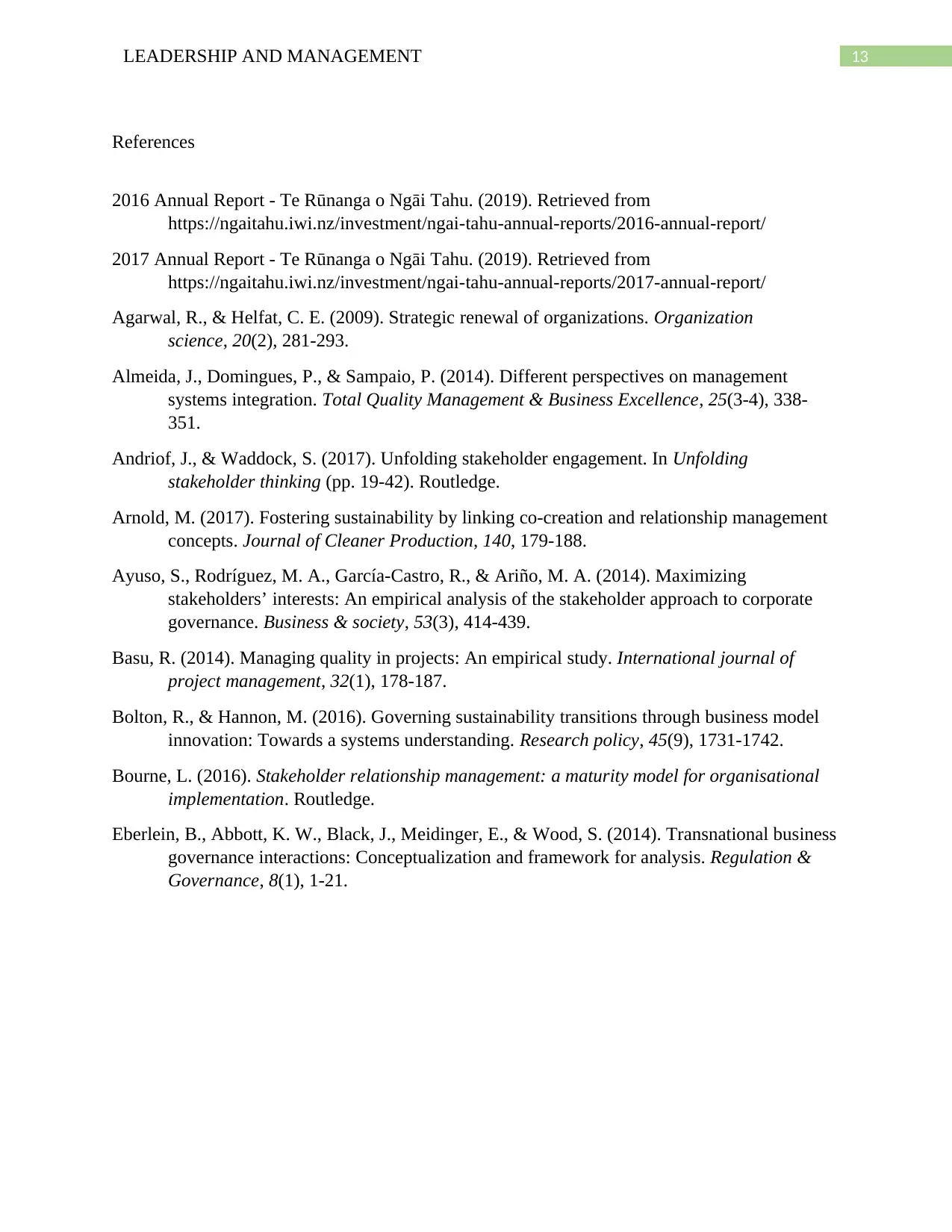
13LEADERSHIP AND MANAGEMENT
References
2016 Annual Report - Te Rūnanga o Ngāi Tahu. (2019). Retrieved from
https://ngaitahu.iwi.nz/investment/ngai-tahu-annual-reports/2016-annual-report/
2017 Annual Report - Te Rūnanga o Ngāi Tahu. (2019). Retrieved from
https://ngaitahu.iwi.nz/investment/ngai-tahu-annual-reports/2017-annual-report/
Agarwal, R., & Helfat, C. E. (2009). Strategic renewal of organizations. Organization
science, 20(2), 281-293.
Almeida, J., Domingues, P., & Sampaio, P. (2014). Different perspectives on management
systems integration. Total Quality Management & Business Excellence, 25(3-4), 338-
351.
Andriof, J., & Waddock, S. (2017). Unfolding stakeholder engagement. In Unfolding
stakeholder thinking (pp. 19-42). Routledge.
Arnold, M. (2017). Fostering sustainability by linking co-creation and relationship management
concepts. Journal of Cleaner Production, 140, 179-188.
Ayuso, S., Rodríguez, M. A., García-Castro, R., & Ariño, M. A. (2014). Maximizing
stakeholders’ interests: An empirical analysis of the stakeholder approach to corporate
governance. Business & society, 53(3), 414-439.
Basu, R. (2014). Managing quality in projects: An empirical study. International journal of
project management, 32(1), 178-187.
Bolton, R., & Hannon, M. (2016). Governing sustainability transitions through business model
innovation: Towards a systems understanding. Research policy, 45(9), 1731-1742.
Bourne, L. (2016). Stakeholder relationship management: a maturity model for organisational
implementation. Routledge.
Eberlein, B., Abbott, K. W., Black, J., Meidinger, E., & Wood, S. (2014). Transnational business
governance interactions: Conceptualization and framework for analysis. Regulation &
Governance, 8(1), 1-21.
References
2016 Annual Report - Te Rūnanga o Ngāi Tahu. (2019). Retrieved from
https://ngaitahu.iwi.nz/investment/ngai-tahu-annual-reports/2016-annual-report/
2017 Annual Report - Te Rūnanga o Ngāi Tahu. (2019). Retrieved from
https://ngaitahu.iwi.nz/investment/ngai-tahu-annual-reports/2017-annual-report/
Agarwal, R., & Helfat, C. E. (2009). Strategic renewal of organizations. Organization
science, 20(2), 281-293.
Almeida, J., Domingues, P., & Sampaio, P. (2014). Different perspectives on management
systems integration. Total Quality Management & Business Excellence, 25(3-4), 338-
351.
Andriof, J., & Waddock, S. (2017). Unfolding stakeholder engagement. In Unfolding
stakeholder thinking (pp. 19-42). Routledge.
Arnold, M. (2017). Fostering sustainability by linking co-creation and relationship management
concepts. Journal of Cleaner Production, 140, 179-188.
Ayuso, S., Rodríguez, M. A., García-Castro, R., & Ariño, M. A. (2014). Maximizing
stakeholders’ interests: An empirical analysis of the stakeholder approach to corporate
governance. Business & society, 53(3), 414-439.
Basu, R. (2014). Managing quality in projects: An empirical study. International journal of
project management, 32(1), 178-187.
Bolton, R., & Hannon, M. (2016). Governing sustainability transitions through business model
innovation: Towards a systems understanding. Research policy, 45(9), 1731-1742.
Bourne, L. (2016). Stakeholder relationship management: a maturity model for organisational
implementation. Routledge.
Eberlein, B., Abbott, K. W., Black, J., Meidinger, E., & Wood, S. (2014). Transnational business
governance interactions: Conceptualization and framework for analysis. Regulation &
Governance, 8(1), 1-21.
1 out of 13
Related Documents
Your All-in-One AI-Powered Toolkit for Academic Success.
+13062052269
info@desklib.com
Available 24*7 on WhatsApp / Email
![[object Object]](/_next/static/media/star-bottom.7253800d.svg)
Unlock your academic potential
© 2024 | Zucol Services PVT LTD | All rights reserved.





